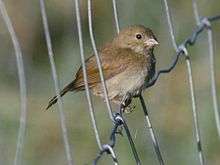Black-faced grassquit
The black-faced grassquit (Melanospiza bicolor) is a small bird. It is recognized as a tanager closely related to Darwin's finches. It breeds in the West Indies except Cuba, on Tobago but not Trinidad, and along the northern coasts of Colombia and Venezuela.
| Black-faced grassquit | |
|---|---|
_male.jpg) | |
| male, Jamaica | |
_female.jpg) | |
| female, Jamaica | |
| Scientific classification | |
| Kingdom: | Animalia |
| Phylum: | Chordata |
| Class: | Aves |
| Order: | Passeriformes |
| Family: | Thraupidae |
| Genus: | Melanospiza |
| Species: | M. bicolor |
| Binomial name | |
| Melanospiza bicolor (Linnaeus, 1766) | |
| Synonyms | |
| |
Breeding
This is a common bird in long grass or scrub in open or semi-open areas, including roadsides and ricefields. It makes a domed grass nest, lined with finer grasses, and placed low in a bush or on a bank. The typical clutch is two or three whitish eggs blotched with reddish brown. Both sexes build the nest and feed the young.

Description
Adult black-faced grassquits are 10.2 cm long and weigh 10.5 g. They have a short conical black bill with an obvious curve to the culmen. The male is olive green above, paler grey-olive below, and has a black head and breast. Female and immature birds have dull olive-grey upperparts and head, and paler grey underparts becoming whiter on the belly.
Males on the South American mainland have more extensively black underparts, shading to a grey belly.
Diet
The black-faced grassquit feeds mainly on seeds, especially of grasses and weeds. It is often found in small groups, but is solitary at evening roosts.
Call
The male has a display flight in which he flies for short distances, vibrating his wings and giving a buzzing dik-zeezeezee call.
References
- BirdLife International (2012). "Melanospiza bicolor". IUCN Red List of Threatened Species. 2012. Retrieved 26 November 2013.CS1 maint: ref=harv (link)
- French, Richard (1991). A Guide to the Birds of Trinidad and Tobago (2nd ed.). Comstock Publishing. ISBN 0-8014-9792-2.
- Hilty, Steven L. (2003). Birds of Venezuela. London: Christopher Helm. ISBN 0-7136-6418-5.
External links
- Black-faced Grassquit videos, photos & sounds on the Internet Bird Collection
